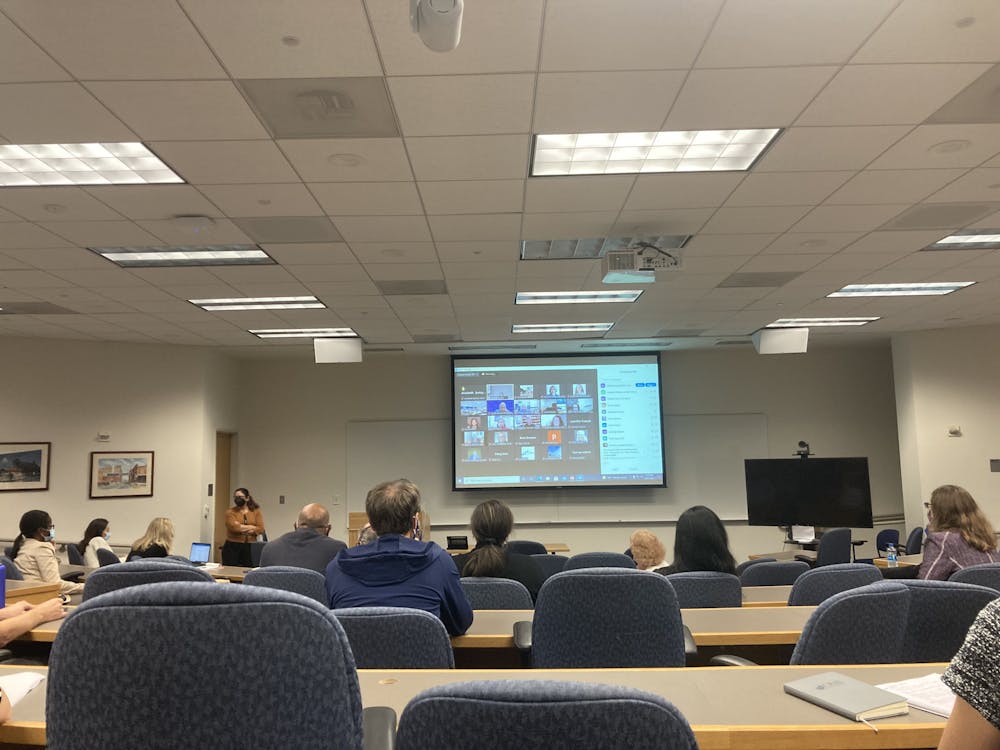Duke still has a long way to go in helping its female faculty and faculty of color—particularly Hispanic and Black female faculty—feel like they belong and are treated equally, according to the results of the University’s 2020 faculty survey.
The survey results, presented by Provost Sally Kornbluth at Thursday’s Academic Council meeting, show stark disparities in how faculty feel about the environment and opportunities in their departments.
Only 20% of Black female faculty who were surveyed and 23% of Hispanic female faculty “somewhat or strongly” agreed with the statement: “I feel that the climate and opportunities for minority faculty in my department/unit are as least as good as those for nonminority faculty.”
In contrast, 47% of Asian female faculty and 42% of white female faculty agreed with the statement.
Gender also made a difference: in every racial category, a smaller percentage of female faculty than male faculty agreed with the statement.
The survey was last administered in 2015, and results for this question revealed a decline over time in faculty’s confidence in the opportunities available for minority faculty. For instance, 40% of Black male faculty said they agreed with the above statement in 2015, but only 25% agreed in 2020. This decline was true for almost all gender and racial categories, except for Asian female faculty and Hispanic male faculty.
“Despite our efforts to really diversify and to build a more inclusive environment, there are still clearly issues with belonging and inclusion,” Kornbluth said.
The survey also dealt with the issue of opportunities for female faculty. One question asked faculty to express whether they agreed with the statement: “I feel that the climate and opportunities for female faculty in my department/unit are at least as good as those for male faculty.”
Within each racial category, a smaller percentage of female faculty than male faculty agreed with the statement. The lowest percentages of agreement were for Black and Hispanic female faculty, at 45% and 43.6%, respectively.
Respondents were also asked to express whether they “somewhat or strongly” agreed with the statement: “I have to work harder than some of my colleagues to be perceived as a legitimate scholar.” Again, there were disparities between male and female faculty and between faculty of color and white faculty. A larger percentage of female faculty agreed with the statement compared to male faculty: for instance, 61.1% of Hispanic female faculty agreed compared to 24.3% of their male counterparts.
Among female faculty, a greater percentage of Black and Hispanic faculty agreed with the statement compared to white or Asian female faculty, with the highest percentage being 76.3% of Black female faculty. Among male faculty, the highest percentage was for Black faculty, at 58.3%.
Besides diversity and inclusion, the survey also asked questions related to retention. Overall, the survey showed that if they had to decide all over again, most faculty would still choose to come to Duke. The percentage of faculty who would do so increased with rank.
But Black and Hispanic people were more likely to have second thoughts or would not choose to come to Duke, according to Kornbluth.
“I’m really curious about what the university's strategy is to respond to this issue. Do we have an overall university strategy?” asked Trina Jones, Jerome M. Culp professor of law.
Kornbluth said that recruitment and retention of Black faculty has improved over the years. She also said change has to happen between faculty and within departments.
“A lot of this is very local,” she said, adding that many of the issues in diversity and inclusion stem from “faculty to faculty treatment.”
Kornbluth plans to encourage “organic faculty-grown activities.” She also said the University is expanding its educational offerings regarding diversity and inclusion and that more faculty have shown interest in learning about these issues.
Kornbluth also shared survey results that evaluated faculty satisfaction and the degree to which faculty embraced a set of shared values.
Overall satisfaction remained high among faculty, according to the survey results. Faculty were generally most satisfied with the quality of students, the intellectual stimulation from their work and library resources. They were most dissatisfied with time and money: they wanted more funding and more time for research.
As for shared values, minority and female faculty were less likely to agree that the shared values of trust and inclusion are reflected in their department or unit. Minority and female faculty were also less likely to agree that the academic leadership in their department effectively addresses unprofessional behavior among faculty.
Get The Chronicle straight to your inbox
Signup for our weekly newsletter. Cancel at any time.

Chris Kuo is a Trinity senior and a staff reporter for The Chronicle's 118th volume. He was previously enterprise editor for Volume 117.

